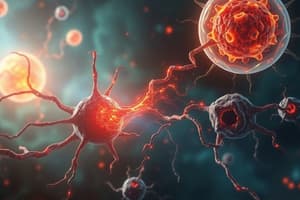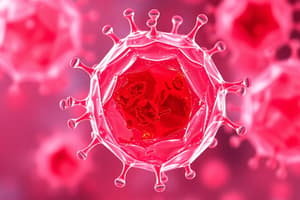Podcast
Questions and Answers
What is the primary physiological consequence of hypoxia on cellular function?
What is the primary physiological consequence of hypoxia on cellular function?
- Reduced oxidative phosphorylation (correct)
- Increased ATP production
- Enhanced Na⁺-K⁺ pump activity
- Elevated aerobic glycolysis
Which condition is characterized by low oxygen pressure in the blood despite normal oxygen levels in the tissues?
Which condition is characterized by low oxygen pressure in the blood despite normal oxygen levels in the tissues?
- Ischemia
- Decreased oxygen-carrying capacity
- Anemia
- Hypoxemia (correct)
What initiates the transition from reversible to irreversible cellular injury?
What initiates the transition from reversible to irreversible cellular injury?
- Complete loss of ATP (correct)
- Reversal of sodium and water buildup
- Increased oxidative phosphorylation
- Membrane stabilization
What is a potential cause of ischemia?
What is a potential cause of ischemia?
Which of the following does not contribute to hypoxemia?
Which of the following does not contribute to hypoxemia?
What is the hallmark of reversible cellular injury?
What is the hallmark of reversible cellular injury?
Which situation contributes to the decreased capacity of hemoglobin to carry oxygen?
Which situation contributes to the decreased capacity of hemoglobin to carry oxygen?
What cellular process is disrupted when ATP levels fall due to hypoxia?
What cellular process is disrupted when ATP levels fall due to hypoxia?
Flashcards are hidden until you start studying
Study Notes
Hypoxia
- Low oxygen delivery to tissues, a major cause of cellular damage
- Oxygen acts as the final electron acceptor in oxidative phosphorylation, a process that generates ATP
- Decreased oxygen impairs oxidative phosphorylation, resulting in reduced ATP production
- Lack of ATP, the essential energy source, leads to cellular injury
- Causes of Hypoxia:
- Ischemia: Reduced blood flow to an organ due to:
- Decreased arterial perfusion (e.g., atherosclerosis)
- Impaired venous drainage (e.g., Budd-Chiari syndrome)
- Shock: Generalized hypotension, leading to inadequate tissue perfusion
- Hypoxemia: Low partial pressure of oxygen in the blood (PaO₂ < 60 mmHg, SaO₂ < 90%)
- High Altitude: Decreased barometric pressure leads to reduced PaO₂
- Hypoventilation: Increased PaCO₂ results in decreased PaO₂
- Diffusion Defect: Thickened diffusion barrier (e.g., interstitial pulmonary fibrosis) hinders oxygen transfer into the blood
- V/Q Mismatch: Blood bypasses oxygenated lungs (circulation problem, e.g., right-to-left shunt) or oxygenated air cannot reach blood (ventilation problem, e.g., atelectasis)
- Decreased Oxygen-Carrying Capacity:
- Anemia: Reduced red blood cell mass, leading to normal PaO₂ and SaO₂
- Carbon Monoxide Poisoning: CO binds to hemoglobin, hindering oxygen transport
- Ischemia: Reduced blood flow to an organ due to:
- Treatment for certain types of hypoxia may involve intravenous methylene blue, which helps reduce Fe³⁺ to Fe²⁺, promoting oxygen transport
Reversible and Irreversible Cellular Injury
- Hypoxia disrupts oxidative phosphorylation, causing a decrease in ATP production
- Low ATP levels impact critical cellular functions:
- Na⁺-K⁺ Pump: Reduced activity leads to sodium and water accumulation within the cell
- Ca²⁺ Pump: Impaired function results in calcium buildup in the cytoplasm
- Aerobic Glycolysis: Switch to anaerobic glycolysis occurs, leading to lactic acid buildup, lowering pH, and damaging proteins and DNA
- The initial phase of cellular injury is reversible
- The hallmark of reversible injury is cellular swelling
- Cytosol swelling leads to loss of microvilli and membrane blebbing
- Rough endoplasmic reticulum (RER) swelling causes ribosome dissociation, decreasing protein synthesis
- Irreversible injury occurs when the damage progresses beyond repair
- The hallmark of irreversible injury is membrane damage
Studying That Suits You
Use AI to generate personalized quizzes and flashcards to suit your learning preferences.





